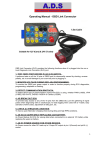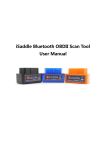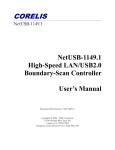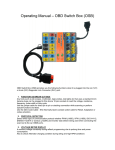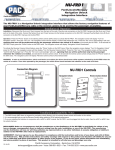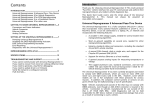Download User Manual - images.mycdmm.de
Transcript
X-431 Diagnosis Aid User Manual V 1.00.000 07.05.2012 How to use 1. Switch the ignition key to OFF position. Connect the OBD Link Connector to the DLC on vehicle. Turn ignition key back to ON position. As soon as it powers up, the voltmeter will display the battery volts and automatically check each of 16 pins of the diagnostic port in the case of stable state event or in the case of single impulses. 2. LED indicator Once the test is completed in less than 10 second, the result will be shown. 3. As Power source: While connected to the car DLC, you can tap +12V at the red banana socket (pin 16) and Chassis Ground (-) at black banana socket (pin 4) to power other DC loads. Capacity rated at 5 Amps. 4. Detecting Protocol in use: Plug your scan tool or interface to OBD Link connector to view live data stream. Check the flashing LEDs and match them with the protocols marked on the label of the OBD Link Connector Always turn ignition key to OFF position before removing the tool. 5. Act as Data Saver: Connect the OBDII cable with battery clips to OBD Link Connector. Turn ignition key to OFF and connect the tool to the car DLC. Attach the battery clip to an external battery (not the battery from the same car). The OBD Link Connector will display the battery voltage and now it is ready to proceed for replacing the car battery. After job done, remove the battery clips from the external battery, unplug the tool from the car. 6. Check Alternator charging condition: With ignition key in OFF position, plug OBD Link Connector into the car DLC. Switch key to ON position and the tool will display the battery voltage. Start the engine; observe the voltage display while the engine is idling. It should be above 12.6 Volts. If not, check for loose drive belt. Then rev engine up to 3,000rpm and observe the change in voltage. If the voltage is above 15.2 Volts, the alarm will beep indicating that the charging voltage is too high. In this case, the regulator needs to be checked. Then switch ON all electrical loads, rev engine to 2,000rpm and observe the changes in voltage at the tool. The voltage should above 13.6 Volts. If the voltage is below, check for loose drive belt and the Alternator. Some Typical Applications: VW - To protect the Scan tool such as aftermarket radios on VW's GM - Transmitter Programming on some GMs Honda - Set the ECM in SCS mode with your scan tool connected Lexus - Help diagnose electronics systems (Sirius, GPS) on pin 6 and 14 Bosch Troubleshoot Bosch controllers that short Proton - needs to short pin 1 to ground in order to access into Toyota Avanza - the base RPM can only be achieved by shorting pin 4 and 12 to OBD2 ground functions. LEDs Activity: OBDII Protocol Detector & Breakout Box LEDs allows you to keep tabs on power and ground. It identifies the protocol used in the vehicle. 1. RED LEDs (Pin 16) - automatically turn-on as soon as you plugged into DLC. RED LEDs turn dim when: Low battery voltage - refer to Voltmeter and alarm will beep (below 12V). Wiring to DLC pin 16 is faulty Grounds circuits has resistance issues 2. GREEN LEDs (Pins 4 and 5) - automatically turn-on as soon as you plugged into DLC. Ground LEDs (Pin 4 and 5) is connected to battery voltage through pin 16. Therefore, a ground supply on pin 4 will not affect LED 5. A dim single green LED will indicate a circuit problem with the corresponding circuit. 3. BLUE LEDs (Pins 2, 6, 7 and 10) - LEDs should flash when serial data voltage pulses are present in the data line. Blue LEDs is assigned on pins 2, 6, 7 and 10 to indicate communication with scan tool or interface and for communication protocol identification. It will turn-on depend on your vehicle model. For some vehicle model, none or multiple blue LEDs will turn-on as soon as our Breakout Box is connected and you start the ignition. The brightness of the LEDs depends on the nature of the signal it's pursuing. This Breakout Box can indentify immediately the protocol used. The better way to indentify the protocol in use is to set-up the scan tool or interface in to LIVE DATA. This will lead in a constant data stream between the scan tool and the vehicle, and then you can locate the LEDs that are flashing. 4. YELLOW LEDs (Pins 1, 3, 8, 9, 11, 12, and 13) - it should flash when your vehicle manufacturer use either one on the pins for any function they prefer. Pin Assignments Pin # SAE Designation 1Discretionary 2Bus + Line of SAE J1850 (PWM/VPW) 3Discretionary 4Chassis Ground 5Signal Ground 6CAN High of SAE J2284 (ISO 15765-4) 7K Line ( ISO 9141-2 and ISO 14230-4) 8Discretionary 9Discretionary 10 Bus-Line of SAE J1850(PWM) 11 Discretionary 12 Discretionary 13 Discretionary 14 CAN Low of SAE J2284 (ISO 15765-4) 15 L Line (ISO 9141-2 and ISO 14230-4) 16 Unswitched Vehicle Battery Positive Pins listed as "Discretionary" indicate that the vehicle manufacturers may used them for specified purpose. Check with the manufacturer's specifications for these connections. For voltage and current limits, refer to SAE J1962 (ISO 15031-3.3). Test tool must not draw more than 1.5 amps through the pin number 5 (Signal ground). Helpful Tips: When activating some ABS and diagnostics wires to recover flash code, you can use pin 4 or pin 5. To power small DC loads with maximum 5 Amps you can use pin 16. If red (power) and green (grounds) LEDs turned dim or flickering when you plugged a scan tool supplied via DLC, it indicate a problem with your vehicle wiring that causes the voltage to drop. Product Specifications: Operating range: 7.0 ~ 24.0VDC Input. Maximum Load: Up to 5.0 Amps. Output. Overload Protection: Yes- PTC Fuse (Self-healing) Monitoring Voltages: Below 12V beeper ON; Higher than 15.2V beeper ON. Volt Displays: 3 Digits LEDs (Resolution: 0.1V) Banana Sockets: 16 outputs x 4.0mm diameter with LED lamp indications. Protocols Detected: PWM (J1850), VPW (J1850), ISO 9141-2, DIS/ISO 14230-4, Canbus (J-2284). OBDII connection: Total including tool: 88mm length. Operating temperature: 0 Deg.C ~ 50 Deg.C (32 Deg.F~122 Deg.F) Permitted Humidity: Less than 70%. Data Saver cable: 2.0 meter length. Reverse Polarity protection: Yes with LED lights up when in correct polarity.










